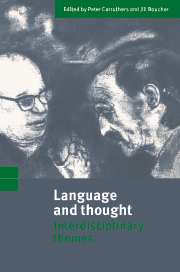Book contents
- Frontmatter
- Contents
- List of contributors
- Preface
- 1 Introduction: opening up options
- Part I Language, development and evolution
- Part II Language, reasoning and concepts
- Introduction to part II
- 6 Aphasic language, aphasic thought: an investigation of propositional thinking in an a-propositional aphasic
- 7 Representing representations
- 8 Magic words: how language augments human computation
- 9 The mapping between the mental and the public lexicon
- 10 Convention-based semantics and the development of language
- Part III Language and conscious reasoning
- References
- Author index
- Subject index
9 - The mapping between the mental and the public lexicon
Published online by Cambridge University Press: 08 January 2010
- Frontmatter
- Contents
- List of contributors
- Preface
- 1 Introduction: opening up options
- Part I Language, development and evolution
- Part II Language, reasoning and concepts
- Introduction to part II
- 6 Aphasic language, aphasic thought: an investigation of propositional thinking in an a-propositional aphasic
- 7 Representing representations
- 8 Magic words: how language augments human computation
- 9 The mapping between the mental and the public lexicon
- 10 Convention-based semantics and the development of language
- Part III Language and conscious reasoning
- References
- Author index
- Subject index
Summary
Introduction
There are words in the language we speak and concepts in our minds. For present purposes, we can use a relatively common-sense, unsophisticated notion of a linguistic word. A bit more needs to be said, now and later, about what we mean by a concept. We assume that mental representations have a structure not wholly unlike that of a sentence, and combine elements from a mental repertoire not wholly unlike a lexicon. These elements are mental concepts: so to speak, ‘words of Mentalese’. Mental concepts are relatively stable and distinct structures in the mind, comparable to entries in an encyclopaedia or to permanent files in a data-base. Their occurrence in a mental representation may determine matching causal and formal (semantic or logical) relationships. On the one hand, there are relationships between the mind and the world. The activation of a concept may play a major role in causal interactions between the organism and external objects that fall under that concept. On the other hand, there are relationships among representations within the mind. The occurrence of a concept in a mental representation may play a causal role in the derivation of further representations, and may also contribute to the justification of this derivation.
Three types of mapping
What kind of mapping is there (if any) between mental concepts and public words? One extreme view is that natural languages such as English or Swahili are the sole medium of thought. In this case, obviously, there is a genuine one-to-one correspondence between public words and mental concepts.
- Type
- Chapter
- Information
- Language and ThoughtInterdisciplinary Themes, pp. 184 - 200Publisher: Cambridge University PressPrint publication year: 1998
- 108
- Cited by



